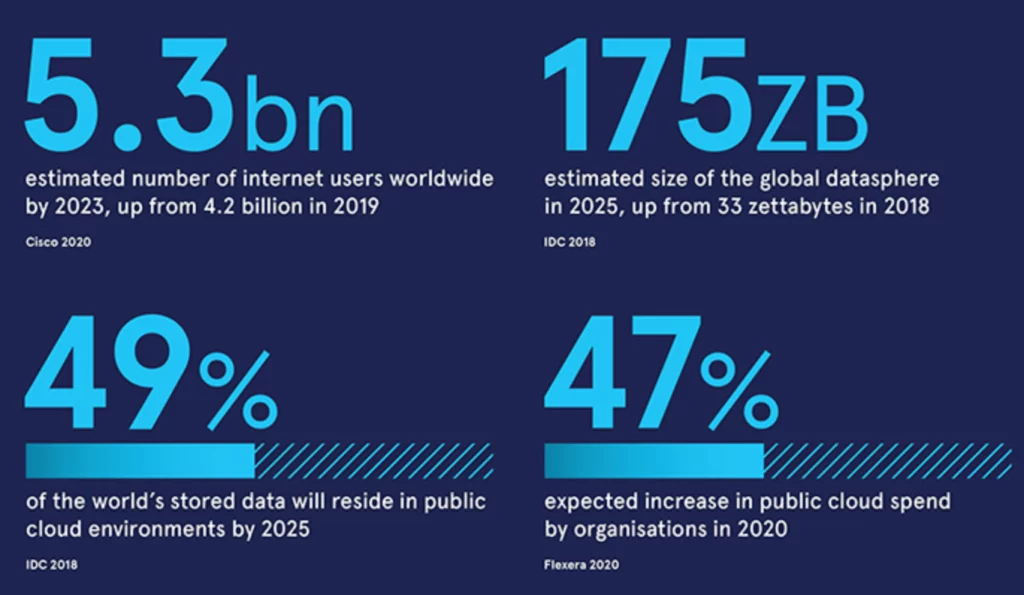Cloud companies and SaaS (Software-as-a-Service) companies have been growing in prominence for years now, but many analysts suggest that this is only the beginning.
Gartner, for instance, predicted that in 2020, the global public cloud services market would grow from almost $243 billion in 2019 to around $258 billion in 2020. In large part, this growth will have been driven by COVID-19 and the demand for telecommuting tools.
Forrester believes that this trend will continue in 2021 and that the global public cloud infrastructure market will grow by 35% to $120 billion.
To better understand why cloud computing is growing so rapidly – and why it is so crucial for modern businesses – it is necessary to understand exactly what cloud technology is and what its benefits are.
What is the cloud?
“The cloud” is shorthand for cloud computing, a type of computing infrastructure that delivers computing services online and on-demand.
Instead of using on-site data centers or desktop computers to provide storage, software, and computing, businesses that leverage cloud technology will often rent these services from cloud companies.

For instance, a company that wants immediate access to a scalable IT infrastructure may rent computing resources from a company such as Amazon Web Services (AWS). Those cloud servers can then be configured, scaled, and used as needed.
Another common use case is SaaS. Companies using SaaS platforms, such as the online version of Microsoft Office or Salesforce, can access those applications over the internet, without needing to install them on a local machine.
These are just two examples of cloud computing, however.
A few others include:
- Infrastructure-as-a-Service (IaaS)
- Platform-as-a-Service (PaaS)
- Database-as-a-Service (DBaaS)
Cloud computing, in short, is a key enabler in the as-a-service business model – a model that offers a number of advantages to companies that migrate to the cloud.
Why cloud is a key step in every digital transformation journey
Cloud computing, SaaS, and other “as-a-service” solutions are beneficial to both cloud companies and their clients.
A software company that delivers software over the cloud, for instance, can release new products, roll out new updates, and innovate more rapidly. After all, they don’t need to worry about the logistics of software distribution or on-site maintenance.
Companies that migrate to the cloud can also reap several benefits, such as:
Lower costs. Most cloud solutions have straightforward pay-as-you-go pricing models, which can significantly cut IT costs. As mentioned, cloud computing and IaaS can usually be scaled up and down as needed, which is almost always cheaper than investing in physical servers.
Simplicity. Deploying software takes time, energy, and resources, and that workload often falls onto the shoulders of IT teams. Cloud solutions, however, often remove that burden entirely, freeing up IT resources to focus on more valuable activities.
Flexibility. As many companies discovered in 2020, cloud computing is a must-have for the remote workforce. Since SaaS platforms can be used from anywhere, employees can stay productive even if they are working from home.

Scalability. Companies that invest in the cloud can increase or decrease users or resources easily and quickly. For organizations that are undergoing change, that scalability makes it easy for companies to build out IT services, adopt new ones, or scale down if needed.
Advantages such as these are compelling enough to convince many businesses to adopt cloud technology.
However, it is perhaps more important to understand that cloud computing is not just beneficial, it is a mandatory step in the process of digitization and digital transformation.
Just as the internet and mobile have become essential for today’s digital business, cloud computing, AI, and other emerging technologies will also become standard.
Over time, those that adopt these new technologies will evolve and become digital leaders, while those that fail to adapt will get left behind.
The future of cloud companies and cloud computing
As we have seen, the cloud computing industry will continue to expand in the years ahead, and it is becoming a fundamental pillar of the digital enterprise.
Here are a few other trends to watch for in the years ahead:
New cloud-enabled operating models. Cloud migration means more than just implementing new digital platforms. To exploit cloud technology to its fullest extent, companies must also roll out new software, new workflows, new business processes, and new cloud operating models.
More multicloud and hybrid cloud. Hybrid clouds connect public clouds, or publicly available cloud resources, to private clouds, which are cloud environments dedicated to individual customers. This orchestration is vital, not only for companies that have migrated to the cloud, but also for upcoming trends in cloud computing, such as edge computing.
Increased adoption of edge computing and fog computing. While cloud computing relies on cloud servers for computing resources, edge computing operates in devices that are located more closely to the users they serve. Among other things, this distributed computing framework can cut response times, reduce bandwidth usage, and improve the user experience.
Companies planning to invest in digital transformation and cloud computing should understand trends such as these, since they will reshape the future of the cloud industry – and, more fundamentally, the way that companies deliver digital goods and services.


